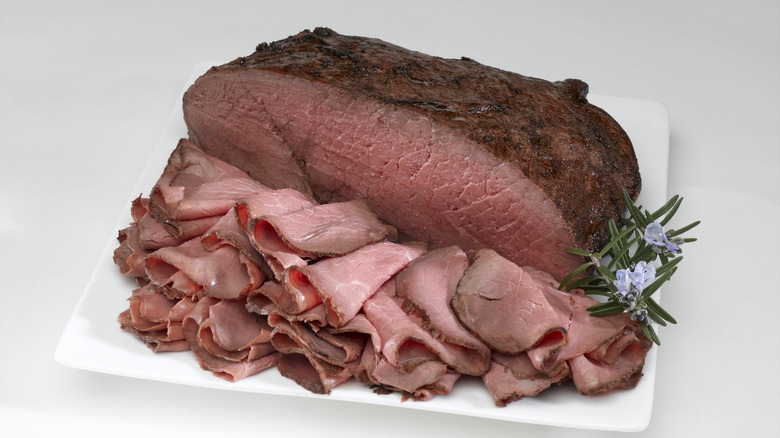The Reason You Might See Random Rainbow Colors On Your Deli Meat
Deli meat is a cheap and easy way to keep yourself fed, so it's no surprise it's a lunch staple, particularly for people who work from home. But sometimes, you pull out your roast beef and get ready to make yourself a sandwich, only to discover your deli meat is now practically glowing with iridescence. Even though it looks cool, you think you should probably throw it away. After all, that can't be safe to eat, right? How could black forest ham doing a Lucky Charms cosplay possibly not run afoul of food safety issues?
Actually, it's completely healthy, and you shouldn't contribute to food waste just because of the appearance. It may look slightly green, but that's not because it's gone bad. Rainbow meat isn't in any way due to spoilage; it's because of the science of how we perceive light — which is where all rainbows come from in the first place.
It's just diffraction grating
There's a couple of principles at play here, but primarily, what's going on is a type of light reflection. Regular rainbows are caused by light refraction in the atmosphere under certain meteorological conditions, and meat rainbows have a perfectly scientific explanation. Meat is a tissue made up of fibers, and when it gets cut for consumption, those fibers are severed to make it easier to chew; this is why you're always supposed to cut meat "against the grain" (the grain is the direction in which those fibers run). When white light hits the severed ends of those fibers, its reflection at different angles creates a rainbow in a process called "diffraction grating." Combine that light reflection with the natural oils present on the surface of any meat and boom: rainbow.
For what it's worth, this doesn't just happen with beef and pork. It's present in poultry like chicken and turkey, too — only they're so pale-colored compared to red meat that it's a lot harder to spot (you can still see it if you look closely, though). Cured meats actually show the phenomenon most clearly, too, since their natural colors tend to be brighter and their surfaces more smooth.
A rainbow doesn't mean bad meat
Unfortunately, people think seeing a rainbow in their meat means it is bad, so a lot of perfectly fine food gets wasted for no good reason. There are far better ways to tell whether meat is bad than: "Does it have a rainbow on it?"
The smell test is — as with pretty much all food — the key here, but you can also look at the texture: bad meat will often be obviously slimy. Mold is another obvious sign of meat that's gone bad, and there are ways to identify if you're seeing good or bad mold, but it's not going to be a rainbow. You can also use expiration dates, but be aware that those are largely made up, and the best test is still your own eyes and nose.
Ultimately, you shouldn't be afraid of rainbow meat, but instead feel safe in the knowledge that it looks interesting and tastes perfectly fine. And honestly, the idea of eating a rainbow sandwich is actually pretty cool.


